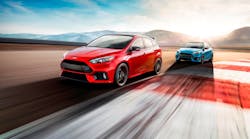Ford Motor Co. is canceling controversial plans to build the Focus small car in Mexico, saving $1 billion by ending North American production entirely and importing the model mostly from China after next year.
The automaker will start making the next-generation Focus in China from the second half of 2019, a year after output ends at one of its plants in Michigan.
Ford will trim about $500 million in costs by shifting production to China, adding to the $500 million already saved from canceling construction of a small-car factory in Mexico earlier this year.
The move is the first major strategic decision Ford has announced under CEO Jim Hackett and marks a complete break from the strategy of his ousted predecessor, Mark Fields, to relocate small car production to Mexico. The company will be testing both consumer appetite for China-built cars and the tolerance of President Donald Trump, who has criticized automakers for importing vehicles from overseas.
“We’ve done a lot of research and consumers care a lot more about the quality and the value than they do about the sourcing location,” Joe Hinrichs, Ford’s president of global operations, said in a conference call on June 20. “iPhones are produced in China, for example, and people don’t really talk about it.”
U.S. Investments
Ford said that it’s investing $900 million at its truck factory in Kentucky to build Expedition and Lincoln Navigator sport utility vehicles, preserving 1,000 jobs. The company emphasized that spending first in a statement Tuesday as Hackett, 62, seeks to avoid the attacks that Trump levied against the automaker under the ex-CEO Fields.
After importing initial production of the new Focus cars from China, Ford said it will later ship variants of the model from Europe. The Michigan Assembly Plant now making the Focus will be retooled to produce the Ranger midsize pickup in late 2018 and the Bronco midsize SUV in 2020.
“China gets a lot of attention, we’ll see how this plays out,” Hinrichs said in response to a question about possible criticism of the move from Trump. “But we believe this is a much better plan for our business globally. And it frees up from the original plan about $1 billion of capital that we can reinvest in the business, including exciting things that we’re working on in autonomy and electrification, and a lot of that work is done right here in the U.S.”
Labor Costs
The move doesn’t signal a broader shift of other Ford models to China, where workers are paid less than they are in Mexico, Hinrichs said.
“Labor costs are cheaper in China than they are in Mexico, but of course you have to take into account the shipping costs, which are significantly higher from China,” Hinrichs said. “So I wouldn’t say this is a variable cost decision. It’s still cheaper to build in Mexico than China for the North American market if you have the capacity.”
Ford will remain a net exporter to China, even after it begins importing Focus models to the U.S., Hinrichs said. The automaker expects to export more than 80,000 vehicles to China this year, including Michigan-built Mustang sports cars and Lincoln Continental luxury sedans.
That should help insulate Ford should Congress levy a border tax on imported goods, Hinrichs said.
“We expect to continue to be a net exporter and have a trade surplus with China even after we start bringing the Focus in,” he said. “We think the significant capital savings outweigh any of the risks associated with any adjustments to the border.”










